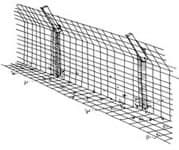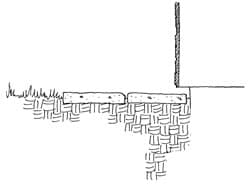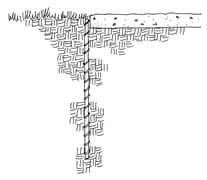Home → Fish & Wildlife → Wildlife → Living with Wildlife → How to Avoid or Resolve a Wildlife Conflict → Fencing
Fencing
Fencing is one option to keep wildlife out of certain areas, prevent damage to trees and shrubs or even gardens, and to protect livestock. The best type of fence for you depends on which species you want to keep out, as well as the size of the area.
If you decide to build or have a fence built by a local contractor, make sure it is constructed properly. A poorly constructed fence is dangerous to wildlife and may not accomplish its purpose.
On this page:
- Fencing for single trees and small groups or trees and shrubs
- Large fenced-in areas
- Electric fences
- Fences with extenders on top and underground
Fencing for single trees and small groups of trees and shrubs
Best used for beaver, rabbits, and hares
The trunks of individual large trees can be loosely wrapped with three-foot high, galvanized welded wire fencing, hardware cloth, or multiple layers of chicken wire.
- Barriers can be painted to make them less noticeable.
- Welded wire fencing coated with green vinyl that helps the fencing blend in is also available.
Lengths of corrugated plastic drainpipe can be attached around the trunks of narrow-diameter trees.
- Dark-colored pipe can burn trunks in full sun; wider diameter pipe or pipe with holes in it may prevent overheating problems.
Painting tree trunks with a sand and paint mix (two thirds cup masonry grade sand per quart of latex paint) has proven somewhat effective at protecting trees from damage. Animals presumably don't like the gritty texture.
Surround groups of trees and shrubs with three-foot high barriers made of galvanized, welded wire fencing or other sturdy material. Stake the barriers to prevent animals from pushing them to the side or entering from underneath.
Large fenced-in areas
Best used for deer, rabbits and hares, skunks, raccoon, and fisher
When properly constructed and maintained, a six- to eight-foot woven-wire fence presents a formidable barrier. The 20-year life span of a well-built fence can justify its cost. Major materials include sturdy, rot-resistant wooden corner posts set in concrete (optional), wooden or studded steel T-line posts, woven-wire fencing and gates. If needed, extensions can be attached to the top of the fence to prevent deer from jumping over. A two-foot high band of chicken wire can be added to the bottom to exclude rabbits and hares.
To prevent wildlife from accessing birds in their night roosts, equip the poultry house with a well-fitting door and a secure locking mechanism. To prevent wildlife from accessing poultry during the day, completely enclose outdoor pens with one-inch chicken wire placed over a sturdy wooden framework. Overlap and securely wire all seams on top to prevent wildlife from forcing their way in by using their weight and claws.
If two widths of woven-wire field fencing are combined, link them with hog rings at approximately 18-inch intervals. To allow small mammals access through the fence, invert the lower fence run so the larger openings are at the bottom.
- Enclose the entire area needing protection (including driveways). Wildlife will wander the perimeter of the fenced area until they find an opening.
- Keep fencing material flush to the ground (including under gates). Fill dips with gravel, rocks, logs, or other suitable material. Incredibly, wildlife will try to either crawl under or squeeze through a fence before jumping over it.
- Wildlife can be excluded from areas with a properly constructed and maintained six- to eight-foot high fence. The higher fence will be needed in an area with many animals and a low supply of wild food. A board fence or hedge that prevents wildlife from seeing a safe landing zone on the other side need be only five and a half feet high.
- The larger the area being enclosed, the more travel patterns will be disrupted, and the more pressure the fence will receive.
- Large areas with high wildlife presence should be fenced with woven-wire fencing or a high-tensile electric wire. Heavy-duty black polypropylene fencing is commercially available and useful where other fencing is visually obtrusive.
- Information on corner bracing, stretching wire, and other fence-building details can be obtained from fencing material suppliers.
Electric fences
Best used for black bear, bobcat, deer, and coyote
A properly designed and maintained electric fence can effectively prevent wildlife from entering an enclosed area as small as a vegetable garden or an area as large as a commercial orchard. One or two hot wires can also be strategically placed to keep other animals out of chicken coops, ponds, and other areas. Electric fences work by delivering a high voltage but low amperage jolt that will not inflict a lasting injury (to either animals or humans) or set fire to plants.
Some fences are built with alternating positive and negative wires, so an animal receives a shock when it touches both wires simultaneously. More commonly, the animal completes the circuit when it touches a hot wire while standing on the ground. The advantage of the second design is that the animal only has to touch one wire to receive a shock. One disadvantage is that plants must be kept from contacting the wire or the fence will short circuit. (Newer low-impedance chargers reduce this problem)
A fence with eight wires evenly spaced to 80 inches is believed to be adequate to keep most wildlife out of an enclosed area. Due to the variables affecting your selection of a power source, and fence design and operation, it is best to consult a reputable dealer for the specifics regarding its use. Information is also available from farm supply centers. Most home improvement centers carry units suitable for protecting gardens. Consult your local zoning office and neighborhood covenants to determine if electric fences are permitted where you live.
- An electric fence is not a physical barrier to entry. It acts as a psychological barrier that some deer will continually test. Therefore, it is important that your fence be properly designed, installed, powered, and maintained.
- To make certain that animals encountering the fence for the first time do not damage the fence or get injured, you must inspect the fence every two days during the first three weeks after installation. After that time, visit at least every two weeks to check the voltage and to rectify any problems, such as sagging wires.
- An electric fence can be less expensive to build than woven wire fences but requires more effort to maintain and will not last as long.
- Recently available electric polywire/tape fencing is much wider and is also meant to work as a visual repellent. It is less expensive, relatively portable, and easy to install. You can easily remove it when mowing or farming, or more it to another location as the need arises.
- Most projects fail because of poor grounding. Rocky or dry ground has poor conductivity.
Fences with extenders on top and underground
Best used for coyote, hares and rabbits, and bobcat
A five-foot woven-wire fence with extenders facing outward at the top of each post should prevent coyotes from climbing into the area to be protected. An effective fence needs to extend at least eight inches below the surface or have a galvanized-wire apron that extends out from the fence at least 15 inches.

Figure 5: Drawing Credit - Jenifer Rees
Fence extensions are required to keep some wildlife from jumping over a five-foot fence. Angle the top of a woven-wire fence out about 15 inches and completely around the fence. An effective fence extends below the surface or has a wire apron in front of it to prevent digging.
Two electrified wires, eight and 15 inches above ground, respectively, and offset from an existing wood fence by 12 inches will prevent coyotes from accessing the fence. A single strand may be sufficient, but two electrified wires will provide added insurance.
Alternatively, install a commercial device, such as the Coyote Roller™, to prevent coyotes from being able to get the foothold necessary to hoist themselves over a fence. (Fig. 8)

Figure 8: Drawing Credit - The Coyote Roller™
The Coyote Roller™ prevents coyotes from being able to get the foothold necessary to hoist themselves over a fence. (Fig. 8)
Enclose poultry (chickens, ducks, and turkeys) in a secure outdoor pen and house. If poultry and eggs are available, coyotes may eat them. (Note: Foxes, skunks, raccoons, feral cats, dogs, bobcats, opossums, weasels, hawks, and owls also kill poultry). You can:
- Equip poultry houses with well-fitted doors and secure locking mechanisms.
- Stake the bottom of the fence flush to the ground, or line the bottom of the fence with bricks, fence posts, or similar items. For ways to prevent coyotes from digging under a fence or structure see Figure 9.

Figure 9a: Drawing Credit - Jenifer Rees

Figure 9b: Drawing Credit - Jenifer Rees

Figure 9c: Drawing Credit - Jenifer Rees
- Completely enclose outdoor pens with one-inch chicken wire placed over a sturdy wooden framework.